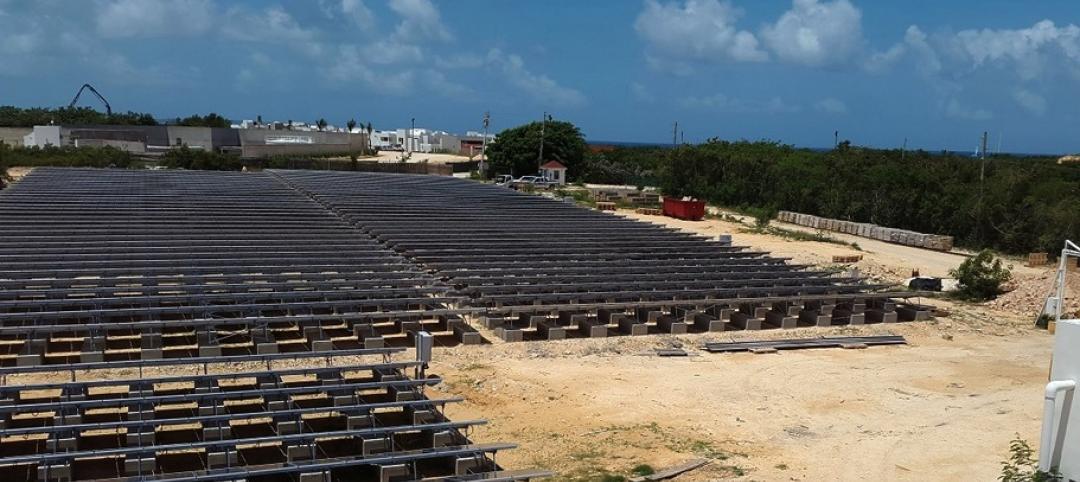An international alliance of green building rating system organizations launched the first guide to facilitate the $35 trillion investment needed by 2030 to meet global energy transition goals.
The international alliance of UK-based Building Research Establishment (BRE), the Green Building Council of Australia (GBCA), the Singapore Green Building Council (SGBC), the U.S. Green Building Council (USGBC), and the Alliance HQE-GBC France developed the guide, Financing Transformation: A Guide to Green Building for Green Bonds and Green Loans, to strengthen global cooperation between the finance and real estate sectors.
“The $35 trillion investment needed to meet global energy transition goals represents almost 10% of the value of global real estate—so we’re talking about investments on a gigantic scale,” says Davina Rooney, CEO of the Green Building Council of Australia (GBCA).
The guide champions a holistic approach by integrating health and social outcomes as critical investment metrics, moving beyond financial and environmental returns.
This transformative shift calls for a fundamental reshaping of traditional practices, encouraging investors to embrace the risks associated with new technologies, scale existing solutions and prioritize social impacts. As such, the alliance is committed to developing criteria in tandem with finance providers to create, measure, and report on social value.
Here is the full press release on the guide:
An international alliance of world-leading green building rating system organizations today announced the launch of the first global practical guide to facilitate the $35 trillion investment needed by 2030 to meet global energy transition goals.
Financing Transformation: A Guide to Green Building for Green Bonds and Green Loans details how various building verification and certification standards can be used to comply with global classifications and bond frameworks, setting a trajectory for the global built environment to meet a sustainable 1.5°C climate threshold.
Gillian Charlesworth, CEO of BRE, said the guide is a testament to the unified international commitment to tackling climate change head-on. “By unlocking significant capital, we can drive the essential decarbonization of our built environment despite the inherent challenges,” Charlesworth said. “This guide represents a monumental first step in coordinating a worldwide movement for green buildings, and we eagerly anticipate further collaboration to meet the challenge of climate change in the sector.”
With buildings accounting for over 30% of global energy use and more than a quarter of emissions, the International Energy Agency (IEA) has warned that the majority of existing buildings will still be standing in 2050, necessitating large-scale capital investments to support sustainable retrofits and meet climate targets.
Davina Rooney, CEO of the Green Building Council of Australia (GBCA), said the alliance will strengthen global cooperation between the finance and real estate sectors, which will be essential in kick-starting the $35 trillion investment needed by 2030. “The $35 trillion investment needed to meet global energy transition goals represents almost 10% of the value of global real estate—so we’re talking about investments on a gigantic scale," Rooney said. “The good news is that this guide demonstrates how working with any of the leading rating tools, whether it’s Green Star, LEED, BREEAM, Green Mark, HQE or NABERS, will ensure a better outcome for people, the planet and your balance sheet.”
The CEO of Singapore's Building and Construction Authority (BCA), Mr. Kelvin Wong, said, "The International Sustainable Finance Guide represents a significant step forward for the built environment, as it will equip investors and financial institutions with the tools to recognize the value proposition of green buildings. We are confident that this initiative will lead to a wider adoption of BCA’s Green Mark Scheme and other similar green building rating systems internationally. This will help catalyze the sustainable growth of the building sector worldwide towards a low-carbon future."
The executive director of the Singapore Green Building Council (SGBC), Yvonne Soh, said the guide will ensure that rating systems can align with finance instruments and bond frameworks worldwide, driving impact on a global scale. “This guide will bring us closer to a world where sustainable development is not just an option, but a cornerstone of global economic activity,” Soh said.
Antoine Desbarrières, president of Alliance HQE-GBC France, said she is proud to contribute to the guide, which demonstrates a collective determination to transform the built environment. “By promoting green finance and robust certification systems, we can accelerate the transition to sustainable buildings and infrastructure. This collaboration is crucial for driving the large-scale changes needed to meet our climate goals," said Desbarrières.
Despite the proliferation of sustainable finance instruments in recent years, their potential is undercut by limited understanding and uptake. The guide’s forward-looking recommendations are designed to bridge this gap, enhancing interactions between the finance and real estate sectors and standardizing green building practices in diverse geographies.
Integrating major building certification systems like BREEAM, Green Mark, Green Star, HQE, LEED and NABERS provides a practical and robust framework for unlocking sustainable finance, ensuring that progress toward a more sustainable built environment is underpinned by scientifically backed, trustworthy methodologies.
The president and CEO of the U.S. Green Building Council (USGBC), Peter Templeton, said the value of directing more capital into buildings and portfolios goes beyond decarbonization. “While meeting our global decarbonization goals is an essential driver, investment in sustainable buildings and portfolios will also deliver measurable improvements to occupant health, community resilience and ecosystem restoration,” said Templeton.
The guide champions a holistic approach by integrating health and social outcomes as critical investment metrics, moving beyond mere financial and environmental returns. This transformative shift calls for a fundamental reshaping of traditional practices, encouraging investors to embrace the risks associated with new technologies, scale existing solutions and prioritize social impacts. As such, the alliance is committed to developing criteria in tandem with finance providers to comprehensively create, measure and report on social value.
Produced by an international alliance comprising the UK-based Building Research Establishment (BRE), the Green Building Council of Australia (GBCA), the Singapore Green Building Council (SGBC), the U.S. Green Building Council (USGBC) and the newly welcomed Alliance HQE-GBC France, this groundbreaking guide marks a significant milestone in the coalition’s efforts to accelerate global climate action. These institutions are behind some of the world’s most influential green building rating systems—BREEAM (BRE), Green Star (GBCA), Green Mark (Singapore’s Building and Construction Authority and SGBC), HQE (Alliance HQE) and LEED (USGBC).
Related Stories
Green | Jun 26, 2015
Training center for electricians in L.A. focuses on net zero technologies
Construction has begun Los Angeles County on what is being called the nation’s largest Net Zero Plus retrofit of a commercial building.
Green | Jun 24, 2015
6 steps toward better water management [AIA course]
When it comes to water conservation, Building Teams tend to concentrate on water-efficient plumbing fixtures, irrigation controls, graywater capture, and ways to recycle condensate from air-conditioning systems. Yet many of the best opportunities for saving water begin with big-picture thinking in a project’s earliest phases.
Green | Jun 19, 2015
3 steps toward sustainable landscape architecture
A water-conscious, sustainable landscape is easily achievable, and the options for native and drought tolerant plants far exceed cacti and succulents, writes LPA's Richard Bienvenu.
Green | Jun 18, 2015
‘Solar water’ poised as global solution
Strapped with both water and energy crises, several island nations are investing in solar-powered water plants to attain more resilient water and power sources.
Lighting | Jun 17, 2015
LED lighting: Replaceable or disposable?
While first generation LED lighting fixtures were basically your standard incandescent or fluorescent housing retrofitted with LED light boards, manufacturers have now begun designing fixtures around the LEDs, writes SmithGroupJJR's Michael Nowicki.
High-rise Construction | Jun 15, 2015
Cornell Tech breaks ground on world's first Passive House residential high-rise
To achieve Passive House standards, Cornell Tech Residential will incorporate a number of sustainability-focused design elements. The façade, constructed of a prefabricated metal panel system, acts as a thermally insulated blanket wrapping the building structure.
Green | Jun 10, 2015
GBCI launches rating system for sustainable landscapes
The new SITES rating system can be applied to development projects located on sites with or without buildings, ranging from national parks to corporate campuses, streetscapes and homes, and much more.
Green | Jun 9, 2015
Fuel cell technology makes its way into energy generation
Demand for fuel cells, while modest, is growing, and cost savings are getting noticed.
Green | Jun 8, 2015
Maryland tech firm is developing spray-on solar panels for windows
Made primarily out of hydrogen and carbon, the coating can turn see-through surfaces into solar panels.




![6 steps toward better water management [AIA course] 6 steps toward better water management [AIA course]](/sites/default/files/styles/list_big/public/VanDusen513.026_grassfix_stairfix.jpg?itok=K8oOWak9)










